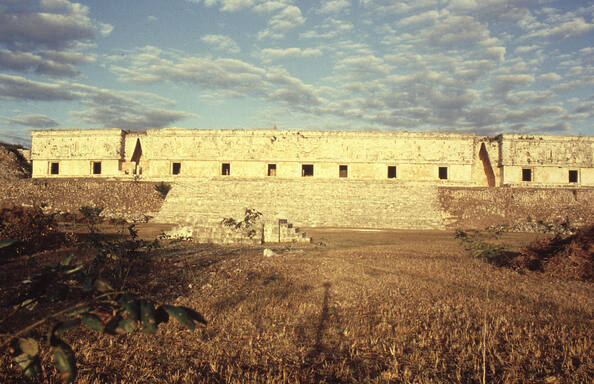乌斯马尔古镇
Pre-Hispanic Town of Uxmal
The Mayan town of Uxmal, in Yucatán, was founded c. A.D. 700 and had some 25,000 inhabitants. The layout of the buildings, which date from between 700 and 1000, reveals a knowledge of astronomy. The Pyramid of the Soothsayer, as the Spaniards called it, dominates the ceremonial centre, which has well-designed buildings decorated with a profusion of symbolic motifs and sculptures depicting Chaac, the god of rain. The ceremonial sites of Uxmal, Kabah, Labna and Sayil are considered the high points of Mayan art and architecture.
La description est disponible sous licence CC-BY-SA IGO 3.0
Ville précolombienne d'Uxmal
La ville maya d'Uxmal, dans le Yucatan, a été fondée vers l'an 700 et compta jusqu'à 25 000 habitants. Construits entre 700 et 1000, ses édifices sont disposés en fonction de données astronomiques. La pyramide du Devin, ainsi nommée par les Espagnols, domine l'espace des cérémonies composé de bâtiments d'une architecture soignée, richement décorés de motifs symboliques et ornés de sculptures représentant Chaac, le dieu de la Pluie. Les sites cérémoniels d'Uxmal, Kabáh, Labná et Sayil constituent l'apogée de l'art et de l'architecture mayas.
La description est disponible sous licence CC-BY-SA IGO 3.0
آثار منطقة اوكسمال التي تعود الى ما قبل اكتشاف كريستوف كولومبوس قارة اميركا
تأسَّست مدينة المايا أوكسمال التي تقع في يوكاتان حوالى العام 700 ويصل عدد سكّانها إلى 25000 تقريبًا. فعماراتها المبنيّة بين العام 700 والعام 1000 منظمة وفقًا لمعلومات فلكية. ويطلّ هرم الديفان كما يسميه الاسبان على المكان حيث تقام الاحتفالات والذي يتألَّف من مبانٍ هندستها مُتقنة ومزينة بزخرفاتٍ رمزيّةٍ وبمنحوتاتٍ تمثل تشاك، اله المطر. ومواقع اوكسمال وكاباه ولابنا وساييل حيث كانت تقام الاحتفالات الدينية تشكل ذروة فن حضارة المايا و هندستها.
source: UNESCO/CPE
La description est disponible sous licence CC-BY-SA IGO 3.0
乌斯马尔古镇
位于尤卡坦的乌斯马尔玛雅城建于公元700年左右,当时约有人口25 000人。城中的建筑都可以追溯到公元700年至1000年间,从当地的城镇布局中我们找到古代天文学思想在其中的体现。西班牙人所称的“占卜者金字塔”是进行宗教仪式的中心,那里有许多设计精巧的房屋,这些房屋都装饰有描写雨神查克的图案和雕刻。乌斯马尔、卡卜、拉巴那以及萨伊尔这些宗教仪式的遗址都代表了玛雅人艺术和建筑的顶峰。
source: UNESCO/CPE
La description est disponible sous licence CC-BY-SA IGO 3.0
Доиспанский город Ушмаль
Город индейцев майя Ушмаль на полуострове Юкатан был основан примерно в 700 г. и имел порядка 25 тыс. жителей. Планировка зданий, относящихся к периоду 700-1000 гг., свидетельствует о наличии у строителей здания астрономии. «Пирамида Колдуна», как ее называли испанцы, доминирует в церемониальном центре, хорошо спроектированные здания которого обильно украшены символическими сюжетами и скульптурами Чака – Бога дождя и плодородия. Церемониальные места Ушмаля, Кабы, Лабны и Сайиля можно рассматривать как самое высокое достижение культуры и архитектуры майя.
source: UNESCO/CPE
La description est disponible sous licence CC-BY-SA IGO 3.0
Ciudad prehispánica de Uxmal
Situada en el Yucatán, la ciudad maya de Uxmal fue fundada hacia el año 700 y llegó a contar con cerca de 25.000 habitantes. La disposición de sus edificios, construidos entre los años 700 y 1000, muestra los conocimientos de astronomía de los mayas. El edificio bautizado por los españoles con el nombre de Pirámide del Adivino domina el centro ceremonial, que está integrado por monumentos de impecable trazado ricamente ornamentados con motivos simbólicos y efigies esculpidas de Chaac, el dios de la lluvia. Los sitios ceremoniales de Uxmal, Kabáh, Labná y Sayil marcan el apogeo del arte y la cultura mayas.
source: UNESCO/CPE
La description est disponible sous licence CC-BY-SA IGO 3.0
古代都市ウシュマル
ユカタン半島北部に700年ごろ建設され、約25000人が住んでいた。チチェン・イッツアなどとともに政治的中心地の一つ。現存する「占い師のピラミッド」「尼僧院」「総督の館」などは高度なマヤ建築の水準を示している。source: NFUAJ
Pre-Spaanse stad Uxmal
De pre-Spaanse Maya stad Uxmal, in Yucatán, werd in 700 na Christus gesticht en had ongeveer 25.000 inwoners. Het ontwerp van de gebouwen – die dateren uit 700 tot 1.000 na Christus – vormt bewijs van een uitstekende astronomische kennis. De ‘Piramide van de Waarzegger’ – zoals de Spanjaarden het noemden – domineert het ceremoniële centrum. In het centrum zijn mooie gebouwen te vinden, rijkelijk versierd met een overdaad aan symbolische motieven en sculpturen van Chaac, de god van de regen. De ceremoniële delen van Uxmal, Kabah, Labna en Sayil worden beschouwd als de hoogtepunten van de Maya kunst en architectuur.
Source : unesco.nl
